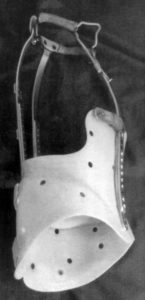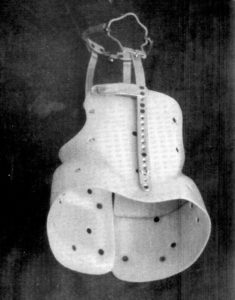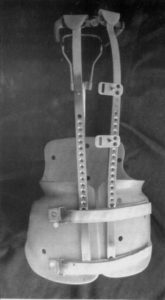A spinal brace treatment:
Scoliosis is defined as a spinal curvature which strays from the symmetrical axis, so that the spine curves to the right or to the left in the Plana frontalia, while in most cases, this curvature is also accompanied by a rotation of the vertebra. The Scoliosis condition may manifest one or more curvatures with varying degrees of deviation, with each placed on a different point of the spine. It is commonly referred to as a C or an S shape.
Although the pain and damage (specified below) this treatment guarantees, the straightening of the spine, for which the treatment is prescribed, is not at all guaranteed. Many times, the Scoliosis manages to ‘defeat’ the brace and the evidence lies in the fact that many boys and girls which have been treated with the brace f

or a prolonged period of time are compelled, at the end of treatment, to undergo surgery.
Since wearing the brace during 23 hours a day limits the movement of many muscles, it obviously stops the natural growth and expected lengthening of the soft tissue if used for a prolonged period while the child is
developing. The reason for this is that the soft tissue lengthens as a result of the changes in the movement range required of it as a reaction to the development and growth of the skeleton. When there is lack of movement there cannot be proper growth. This will result in health as well as aesthetic damage which is inevitable in a state where the soft tissue is ‘a few sizes small’ for the skeleton which it envelopes and with which it is supposed to move in synchronization. This negative outcome of wearing a brace is irreversible.
Another result of fixing the spine in a back brace is the loss of movementability of the joints due to skeletal problems.
Fixating the spine in a brace for a prolonged period prevents the movement of many muscles in the back, and a muscle that is not required to move for a long period becomes atrophied and degenerates. This is an undisputable anatomical fact. A brace ‘graduate’ of this kind will have limited back movement for the rest of his/her life, a limitation which will require excess movement from muscles and joints that were not directly damaged, but are sure to react badly to the movement burden demanded of them as compensation.
Wearing the spine brace has a negative impact on the internal organs in the chest cavity and abdomen.
A chest cavity that grew into the brace mold forms a flat shape.
Pain and skin conditions, are also a result of wearing a brace.
Puberty is a critical age when it comes to developing a body image, and its part in the general self image is important. Teenagers, who wear a spine brace at this time in their lives, might develop a negative self image of their body, and that may result in negative psychological and physical ramifications to the extent of denying the body and its needs.
Wearing the brace may socially alienate the patient. At such a time when social life is such a central aspect, the teenager is abstaining from many social activities: going to the beach, ball games, carrying a backpack in field trips, or dance parties. The inability to partake in many activities popular at that age, might definitely turn the teenager into a social outcast.
From all that was said, we see a result of aesthetic damage in the body’s form as well as in the movement.


